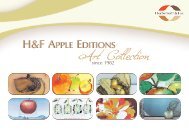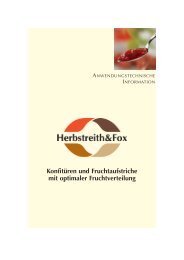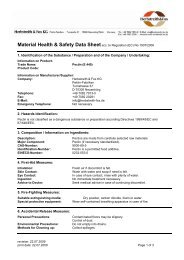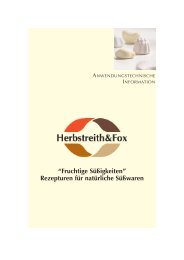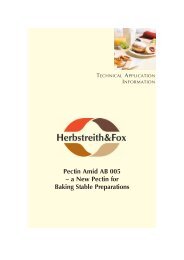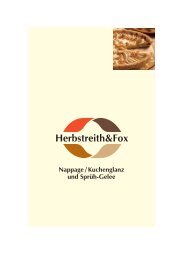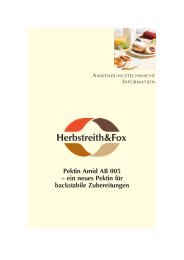Fruit Preparations for Bakery Products - Herbstreith & Fox
Fruit Preparations for Bakery Products - Herbstreith & Fox
Fruit Preparations for Bakery Products - Herbstreith & Fox
You also want an ePaper? Increase the reach of your titles
YUMPU automatically turns print PDFs into web optimized ePapers that Google loves.
<strong>Fruit</strong> <strong>Preparations</strong><br />
<strong>for</strong> <strong>Bakery</strong> <strong>Products</strong>
Content<br />
FRUIT PREPARATIONS FOR BAKERY PRODUCTS 4<br />
REQUIREMENTS ON FRUIT PREPARATIONS FOR BAKERY PRODUCTS 5<br />
Manufacturing of the fruit preparation 5<br />
Baking process 6<br />
After baking 7<br />
STANDARD TESTS TO DETERMINE THE QUALITY 8<br />
Baking stability 8<br />
Tendency to syneresis 10<br />
GELLING BEHAVIOUR OF PECTINS 11<br />
Structure of pectin 11<br />
Gelling mechanisms 11<br />
Factors influencing the gelation of low methylester pectins 13<br />
SPECIFIC INFLUENCE ON TEXTURE AND BAKING STABILITY BY<br />
LOW METHYLESTER H&F CLASSIC PECTIN 17<br />
Setting temperature, pre-gelation and filling temperature 17<br />
Influence of filling temperature on texture 18<br />
Influence of setting temperature on baking stability and surface gloss 19<br />
Influence of calcium salts 22<br />
Use of different fruits 24<br />
HIGH METHYLESTER PECTINS FOR BAKING STABLE FRUIT PREPARATIONS 25<br />
FRUIT PREPARATIONS FOR BAKERY PRODUCTS WITH LOW<br />
SOLUBLE SOLIDS CONTENT 26<br />
2 SELECTED RECIPES WITH H&F PECTINS 27 3<br />
Traditional baking marmalade 27<br />
<strong>Fruit</strong> preparations <strong>for</strong> bakery products 28<br />
<strong>Fruit</strong> fillings 32<br />
SCHEMATIC PRODUCTION PROCESS 34<br />
SPECIAL ADVANTAGES OF H&F CLASSIC APPLE PECTINS 36<br />
PRODUCT RANGE H&F CLASSIC PECTINS 38<br />
Pectins in <strong>Fruit</strong> <strong>Preparations</strong> <strong>for</strong> <strong>Bakery</strong> <strong>Products</strong>
<strong>Fruit</strong> preparations<br />
<strong>for</strong> bakery products<br />
4<br />
<strong>Bakery</strong> products combined with a fruit<br />
preparation are very popular due to their<br />
fresh-fruity flavour.<br />
In the production process of such bakery<br />
products the fruit preparations used are given<br />
onto the cold cakes after baking (e.g. fruit<br />
fillings <strong>for</strong> doughnuts) or they are baked<br />
together with the cake (e.g. Linzer tart).<br />
The fruit preparations named fruit fillings,<br />
which are added to the cake after the baking<br />
process, are expected to show, besides the<br />
required flavour and texture, also very good<br />
properties regarding processing (e.g. pumping,<br />
dosing, injecting).<br />
Fig. 1: <strong>Bakery</strong> products, produced<br />
with fruit fillings, without having<br />
passed a baking process<br />
Baking stable fruit preparations are used <strong>for</strong><br />
bakery products which pass the baking process<br />
together with the dough and which have to<br />
endure the heat emerging during the baking<br />
process without changing their shape and<br />
volume. In addition to the necessary baking<br />
stability they have to possess also excellent<br />
properties regarding processing and to show<br />
the desired texture in the finished product.<br />
In order to reach the required sensory and<br />
technological properties in the production of<br />
different types of fruit preparations <strong>for</strong> bakery<br />
products the importance of using pectin<br />
increases. Especially with H&F Classic Pectins<br />
which are standardized to this application it is<br />
possible – in connection with the appropriate<br />
processing technology – to produce fruit<br />
fillings and baking stable fruit preparations<br />
which meet these requirements to a great<br />
extent.<br />
<strong>Fruit</strong> preparations <strong>for</strong> baked products are<br />
produced as bucket, drum or container goods.<br />
For processing the fruit preparations they are<br />
taken out of the respective packaging and<br />
given or injected to the dough or the finished<br />
cake.<br />
The properties of the fruit preparations themselves<br />
are influenced decisively by processing<br />
technology, recipe parameters (calcium ion<br />
concentration, types of sugar, soluble solids<br />
content, pH-value, type of fruit) and the used<br />
pectin and / or the combination of these<br />
factors.<br />
In order to guarantee an optimal course of<br />
production – starting with the manufacturing<br />
of the fruit preparation, the production process<br />
up to the storage of the finished bakery<br />
product – there are very high demands on<br />
baking stable fruit preparations which can be<br />
fulfilled with the suitable H&F Classic Pectins.<br />
Manufacturing of the fruit preparation<br />
In the industrial production of baking stable<br />
fruit preparations <strong>for</strong> the bakery industry,<br />
these are steadily stressed mechanically during<br />
the cooling phase and then filled into larger<br />
packagings (e.g. containers) in cold condition.<br />
With that the <strong>for</strong>ming of an elastic gel network<br />
is prevented and a non gelled, creamy<br />
and pasty product with the requested firmness<br />
results.<br />
Requirements<br />
on fruit preparations <strong>for</strong> bakery products<br />
After filling and storage in containers the fruit<br />
preparation is expected to be well processable<br />
again and not to change its texture after<br />
mechanical stressing (e.g. pumping, stirring,<br />
dosing). That means a pseudo-plastic texture is<br />
required which is able to regenerate very well.<br />
Additionally no post-gelation or syneresis<br />
(release of water from the gel) may occur<br />
during storage. This product stability over the<br />
whole storage time in the packaging as well as<br />
during the best be<strong>for</strong>e period of the finished<br />
bakery products is of great importance.<br />
Low methylester H&F Classic Pectins offer<br />
very special advantages <strong>for</strong> the production<br />
of baked products<br />
Due to the careful pectin production, the specific<br />
molecular structure and the special standardization<br />
to this application, fruit preparations<br />
with optimal smoothness and, at the same<br />
time, high firmness can be produced meeting<br />
all requirements of the industry.<br />
Fig. 2: <strong>Bakery</strong> products,<br />
produced with baking<br />
stable fruit preparations<br />
having passed a baking<br />
process<br />
Pectins in <strong>Fruit</strong> <strong>Preparations</strong> <strong>for</strong> <strong>Bakery</strong> <strong>Products</strong>
6<br />
<strong>Fruit</strong> preparations <strong>for</strong> baked products, produced with H&F Classic Pectins<br />
are characterized especially by<br />
● excellent pumpability,<br />
● smooth texture and high firmness at the same time,<br />
● high resistance towards mechanical stress,<br />
● excellent regeneration ability, also after mechanical stressing,<br />
● very low tendency to syneresis,<br />
● high tolerance towards varying pH-values of the final product,<br />
● possibility to adjust filling temperature to packaging size,<br />
● surface gloss,<br />
● excellent release of flavour and taste<br />
<strong>Fruit</strong> fillings, which are given onto or injected<br />
in the finished bakery product after the baking<br />
process, show a high viscous and very smooth<br />
and creamy texture providing also the surface<br />
gloss of the fruit layer.<br />
Caused by pumping and dosing, these fruit<br />
fillings are exposed to high mechanical stress.<br />
The challenge of the pectin is to <strong>for</strong>m a stable<br />
texture free from syneresis, with excellent<br />
regeneration ability, that the fruit preparation<br />
maintains its <strong>for</strong>m and freshness after the<br />
dosing and also during a longer storage.<br />
Baking process<br />
Baking stable fruit preparations which are<br />
given on or injected in the dough prior to the<br />
baking process, have to possess limited or full<br />
baking stability, depending on the demands.<br />
Together with the dough the fruit preparation<br />
is exposed to a defined heat <strong>for</strong> a certain time<br />
during the baking process in the oven. If a<br />
fruit preparation is baking stable it will not<br />
change its original shape under this heat. That<br />
means it does not start boiling nor melting<br />
and does also not show syneresis.<br />
Deficient, that means non baking stable fruit<br />
preparations melt under the given conditions<br />
and start to flow or, due to the oven temperature,<br />
they begin to boil and bubbles start<br />
<strong>for</strong>ming because of steam <strong>for</strong>mation. These<br />
bubbles finally escape at the surface resulting<br />
in an undesired and not controllable change of<br />
the product surface. This is also called<br />
”cratering”.<br />
When producing such particular products like<br />
Linzer tart a certain, intended melting of the<br />
fruit preparation during the baking process<br />
may be desired.<br />
If the fruit preparation only melts at the surface<br />
under the given temperature, this will<br />
result in a nice surface gloss giving the cake an<br />
attractive surface without changing the original<br />
shape significantly.<br />
This is called a limited baking stability.<br />
Fig. 3: Baking stable and non baking stable<br />
fruit preparation<br />
After baking<br />
As baking stable fruit preparations are mainly<br />
used <strong>for</strong> bakery products with a long shelf life<br />
it is specially important that the cakes keep their<br />
optimal quality over a longer period of time.<br />
There<strong>for</strong>e the fruit preparation is expected to<br />
be stable also after baking and it may not<br />
release water, i.e. it may not show any tendency<br />
to syneresis.<br />
Ideally the aw-value of the fruit preparation<br />
complies additionally with that of the bakery<br />
product.<br />
With H&F Classic Pectins fully baking stable<br />
and also limited baking stable fruit preparations<br />
with controlled melting of the surface<br />
can be produced.<br />
H&F Classic Pectins guarantee:<br />
● Stability of texture also during longer<br />
storage time<br />
● Specific standardization of the desired<br />
baking stability<br />
● No tendency to syneresis<br />
● Highest functionality also <strong>for</strong> fruit<br />
preparations with an aw-value in the<br />
range of the bakery products<br />
7<br />
Pectins in <strong>Fruit</strong> <strong>Preparations</strong> <strong>for</strong> <strong>Bakery</strong> <strong>Products</strong>
Standard tests<br />
to determine the quality<br />
8<br />
Determination of baking stability<br />
The baking stability of a fruit preparation can<br />
be determined by means of standard tests in a<br />
laboratory.<br />
With these tests a defined amount of fruit<br />
preparation is given onto a base by a metal<br />
ring with defined geometry and is baked<br />
under exactly defined conditions.<br />
Baking<br />
stable<br />
Limited<br />
baking<br />
stable<br />
Non<br />
baking<br />
stable<br />
Fig. 4: Evaluation of baking stability<br />
During and after the baking the changes in<br />
shape and volume are observed and evaluated.<br />
The test conditions are chosen as close to practice<br />
as possible – this resulted in the development<br />
of three standard tests in dependence<br />
from the different demands on fruit preparations.<br />
These tests proved themselves in quality<br />
control.<br />
<strong>Fruit</strong> preparation<br />
Glossy<br />
surface<br />
Baking test 1 (BT1)<br />
Baking test 1 (BT1) is used to evaluate fruit<br />
preparations which are limited baking stable.<br />
The fruit preparation is given onto a short<br />
dough patty by means of a standardized metal<br />
ring and is baked.<br />
Metal ring: 40mm, height 5mm<br />
Short dough patty: 50mm, height 4mm<br />
Baking time: 15minutes<br />
Oven temperature: 200°C<br />
(pre-heated, top and bottom heat)<br />
Baking test 2 (BT2)<br />
Baking test 2 (BT 2) is a more severe test which<br />
is used <strong>for</strong> evaluation of fruit preparations<br />
with high baking stability.<br />
The fruit preparation is given onto a short<br />
dough patty also by means of a standardized<br />
metal ring. However, in comparison to BT 1 the<br />
baking time is longer.<br />
Metal ring: 60mm, height 10mm<br />
Short dough patty: 80mm, height 4mm<br />
Baking time: 20minutes<br />
Oven temperature: 200°C<br />
(pre-heated, top and bottom heat)<br />
Baking test 3 (BT3)<br />
This baking test is even more severe and is<br />
used <strong>for</strong> evaluation of fruit preparations with<br />
a very high baking stability. Instead of the<br />
short dough filter paper is used as base. Thus<br />
the fruit preparation is almost directly in<br />
contact with the baking tray and is exposed<br />
more strongly to the heat from the bottom<br />
than in BT 1 and BT 2.<br />
Metal ring: 60mm, height 10mm<br />
Filter paper: 90mm<br />
Baking time: 20minutes<br />
Oven temperature: 200°C<br />
(pre-heated, top and bottom heat)<br />
Figure 4 shows the evaluation scheme <strong>for</strong> the<br />
above mentioned three baking tests.<br />
A fruit preparation is called baking stable if<br />
during baking it does neither melt nor boil and<br />
no bubble <strong>for</strong>mation or only little changes in<br />
shape and volume occur.<br />
Limited baking stability means that the fruit<br />
preparation shows a slight melting at the<br />
surface without any changes of the original<br />
shape resulting in a nice gloss.<br />
If the fruit preparation has melted completely<br />
it is not baking stable.<br />
Fig. 5: Baking test 3 (left to right limited baking stable, baking stable, not baking stable)<br />
9<br />
Pectins in <strong>Fruit</strong> <strong>Preparations</strong> <strong>for</strong> <strong>Bakery</strong> <strong>Products</strong>
10<br />
Fig. 6: Syneresis test<br />
Evaluation of tendency to syneresis<br />
Syneresis is the discharge of liquid out of a gel<br />
and an undesirable emergence <strong>for</strong> fruit preparations<br />
<strong>for</strong> bakery products.<br />
Syneresis mainly occurs after mechanical<br />
destruction of the gel network. The stronger<br />
the tendency to syneresis, the more liquid can<br />
discharge from the gel. <strong>Fruit</strong> preparations with<br />
syneresis show a diminished baking stability<br />
and, due to the liquid loss, result in discolouring<br />
and soaking of the cake. Furthermore, the fruit<br />
preparation loses freshness and quality caused<br />
by the liquid loss.<br />
Be<strong>for</strong>e and after the baking process, fruit<br />
preparations <strong>for</strong> bakery products are tested<br />
concerning their tendency to syneresis to fulfill<br />
the specific demands as regards production,<br />
baking process and storage.<br />
The fruit preparation is given onto a filter<br />
paper by means of a standardized metal ring.<br />
The filter paper absorbs the water which is not<br />
bound (”syneresis”) with which a ”corona”<br />
around the fruit preparation becomes visible.<br />
The determination of the tendency to syneresis<br />
prior to the baking process is done after a<br />
defined period after placing the fruit preparation<br />
on the filter with measuring the diameter<br />
of this ”corona”. The larger the diameter of<br />
this ”corona” is, the larger is the tendency to<br />
syneresis.<br />
Afterwards this fruit preparation is baked<br />
under exactly defined conditions.<br />
The determination of the tendency to syneresis<br />
after baking is done immediately after the<br />
cooling of the bakery product. For this purpose,<br />
the diameter of the ”corona” is measured<br />
again and additionally the surface of the<br />
fruit preparation is assessed optically. Many<br />
small “craters” caused by elusion of steam,<br />
point at an insufficient binding of water and<br />
with that to a high tendency to syneresis.<br />
Structure of pectin<br />
Pectin is an important structure element of all<br />
plant food. Chemically seen pectin is a macromolecular<br />
substance which belongs to the<br />
heteropolysaccharides. The main part is polygalacturonic<br />
acid which is partially esterified<br />
with methanol.<br />
If the degree of esterification is more than<br />
50% the pectin is a high methylester pectin, if<br />
the degree of esterification is less than 50%<br />
the pectin is a low methylester pectin.<br />
Gelling mechanisms<br />
According to modern theories of gel <strong>for</strong>mation<br />
the regular zones of the pectin macromolecules<br />
bond together to bonding zones during the<br />
gelation process. These bonding zones are<br />
interrupted by the presence of neutral sugar<br />
side chains and so new bonding zones <strong>for</strong>m at<br />
another place. With that the <strong>for</strong>mation of a<br />
three-dimensional network is possible which is<br />
able to immobilize large quantities of water.<br />
Fig. 7: Pectin (polygalacturonic acid, partially esterified)<br />
Gelling behaviour<br />
of pectins<br />
Gel <strong>for</strong>mation of high methylester pectins<br />
For high methylester pectins, on the one side<br />
hydrophobic interactions emerge between the<br />
methylester groups at the adhesive zones<br />
which are necessary <strong>for</strong> gelation. On the other<br />
side, there are hydrogen bonds which may<br />
develop <strong>for</strong> example between free, not dissociated<br />
carboxyl groups of the pectin chains.<br />
At this so called sugar acid gelling mechanism<br />
a high concentration of sugar degrades the<br />
water activity of the system. The pectin chains<br />
are dehydrated and can more easily converge.<br />
The addition of acid causes the repulsion of<br />
the dissociation of free carboxyl groups and<br />
with that the mutual repulsion of negatively<br />
charged pectin molecules is repressed.<br />
Optimal conditions <strong>for</strong> the gelation of high<br />
methylester pectins are a soluble solids content<br />
of more than 60% and a pH-value in the range<br />
of pH 3.0.<br />
11<br />
Pectins in <strong>Fruit</strong> <strong>Preparations</strong> <strong>for</strong> <strong>Bakery</strong> <strong>Products</strong>
12<br />
–<br />
Fig. 8: Formation of adhesive zones during gelation<br />
Ca 2+<br />
Ca 2+<br />
–<br />
Ca 2+<br />
Ca 2+<br />
Ca 2+<br />
Gel <strong>for</strong>mation of low methylester pectins<br />
Low methylester pectins also gel according to<br />
the ”sugar acid gelling mechanism” as high<br />
methylester pectins do. Additionally low<br />
methylester pectins are able to <strong>for</strong>m bonding<br />
zones with bivalent cations e.g. calcium ions.<br />
The binding is effected by complexation of the<br />
bivalent ions (”egg-box” gelling model). The<br />
gelation with calcium ions is relatively independent<br />
from soluble solids content and pHvalue<br />
of the product.<br />
HO<br />
HO COO –<br />
O –<br />
HO<br />
O<br />
O<br />
HO O<br />
HO COO<br />
O<br />
O<br />
O<br />
OH<br />
–<br />
O –<br />
O<br />
O<br />
HO O<br />
O<br />
O<br />
OH<br />
Ca 2+<br />
HO<br />
O<br />
O<br />
OOC<br />
O<br />
O OH<br />
O<br />
O<br />
–<br />
Ca 2+<br />
Ca 2+<br />
Ca 2+<br />
Ca 2+<br />
HO<br />
O<br />
O<br />
OH OOC<br />
O<br />
O OH<br />
O<br />
OH<br />
O<br />
–<br />
OH<br />
O<br />
OH<br />
Factors influencing the gelation of low<br />
methylester pectins<br />
Influence of calcium ion concentration<br />
The calcium ion concentration which is necessary<br />
<strong>for</strong> an optimal gelation thereby depends<br />
on different product parameters such as soluble<br />
solids content, type of sugar (mono- or disaccharide,<br />
sugar alcohols, glycerine, etc.), pHvalue<br />
and buffer system.<br />
If the addition of calcium to the pectin system<br />
is low the pectin chains will start to stick<br />
together through calcium bonds resulting in an<br />
increasing viscosity (see fig. 10).<br />
With an increase of the calcium dosage a gel is<br />
<strong>for</strong>med which will become firmer and more<br />
elastic with increasing calcium dosage.<br />
Fig. 9: “egg box” gelling model Fig. 10: Influence of calcium concentration on the <strong>for</strong>mation of adhesive zones<br />
Ca 2+<br />
Ca 2+<br />
Ca 2+<br />
If the calcium dosage exceeds a defined maximum<br />
a so called pre-gelation will occur under<br />
the given conditions.<br />
If the calcium concentration is increased even<br />
more, then calcium pectinate will precipitate<br />
under the given production conditions.<br />
To obtain baking stable fruit preparations<br />
without syneresis, the calcium ion concentration<br />
has to be selected that way that a controlled<br />
pre-gelation is initiated when cooling<br />
down to the filling temperature. In doing so,<br />
fine gel particles will <strong>for</strong>m and the fruit preparation<br />
reaches the desired pseudoplastic<br />
character.<br />
Pectin-chains<br />
in solution<br />
Chain<br />
association<br />
Precipitation<br />
of calcium<br />
pectinate<br />
13<br />
Pectins in <strong>Fruit</strong> <strong>Preparations</strong> <strong>for</strong> <strong>Bakery</strong> <strong>Products</strong>
14<br />
Influence of the product pH-value<br />
For low methylester pectins, the breaking<br />
strength and the maximum reachable gel<br />
strength decrease if the pH-value of the final<br />
product is raised, the gels become weaker and<br />
the texture more viscous.<br />
With raising the pH-value also the calcium<br />
need, which is necessary to reach a defined gel<br />
strength, increases. Furthermore the working<br />
range becomes wider. This means that gels<br />
with higher pH-values (e.g. pH 4.0) are more<br />
tolerant towards fluctuations of the calcium<br />
content compared with gels with lower pHvalues<br />
(e.g. pH 3.0). With that, in the production<br />
of fruit preparations <strong>for</strong> bakery products<br />
the tolerance range and product safety are<br />
adequately increased.<br />
Raising the pH-value results in an increase of<br />
charged molecules in the gel. Now the calcium<br />
ions react stronger with other negatively<br />
charged buffer substances. With that the share<br />
of calcium ions reacting with the pectin<br />
decreases.<br />
Due to the pH-value conditioned stronger<br />
dissociation of free carboxyl groups the pectin<br />
chains repel mutually more strongly whereby<br />
the gelling strength decreases.<br />
Raising the calcium ion concentration creates<br />
again more cross linkages between pectin<br />
molecules and thus increasing gelling strength.<br />
Breaking strength [HPU]<br />
Parameter:<br />
• low methylester pectin, DE 40%<br />
• sucrose gel with increasing soluble solids content<br />
• 0.1m citric acid / potassium citrate buffer solution<br />
2400<br />
2200<br />
2000<br />
1800<br />
1600<br />
1400<br />
1200<br />
1000<br />
800<br />
600<br />
400<br />
200<br />
60% SS<br />
40% SS<br />
20% SS<br />
pH 3.0<br />
pH 3.5<br />
pH 4.0<br />
10 30 50 70 90 110 130 150 170<br />
Calcium concentration [mg Ca 2+ /g pectin]<br />
Fig. 11: Breaking strength of low methylester pectins in dependence from calcium content under the influence of<br />
soluble solids content and pH-value of the product<br />
Influence of soluble solids content<br />
An important parameter <strong>for</strong> the selection of<br />
suitable pectins <strong>for</strong> fruit preparation <strong>for</strong><br />
bakery products is the soluble solids content<br />
of the <strong>for</strong>mulation, which significantly influences<br />
the gelling properties of low methylester<br />
pectins.<br />
For gels, which are produced with low methylester<br />
pectins, the maximum reachable breaking<br />
strength is highest, when the soluble solids<br />
content is highest. For reaching this maximum<br />
breaking strength resp. <strong>for</strong> <strong>for</strong>ming a comparably<br />
firm gel, a lower dosage of calcium ions<br />
is required at high soluble solids contents<br />
(e.g. 60% SS) than at less high soluble solids<br />
contents (e.g. 20% SS).<br />
At the same time the ”working range”, at<br />
which the gels are firm but not pre-gelled,<br />
becomes wider with decreasing soluble solids<br />
content.<br />
15<br />
Pectins in <strong>Fruit</strong> <strong>Preparations</strong> <strong>for</strong> <strong>Bakery</strong> <strong>Products</strong>
16<br />
sucrose 100<br />
glucose 50<br />
fructose 110<br />
sorbitol 70<br />
Fig. 12: Influence of sugar type<br />
Sweetening Viscosity of Calcium need<br />
power fruit preparations <strong>for</strong> optimal gelation<br />
(constant Ca 2+ dosage)<br />
Influence of sugar type<br />
Besides the sugar concentration also the type<br />
of sugar has an important influence on gelling<br />
properties and baking stability.<br />
Thus the required amount of calcium <strong>for</strong> the<br />
best possible gelation is much higher in gels<br />
with sorbitol than in gels with sucrose. Gels<br />
with fructose and glucose are somewhere in<br />
between. A further influence of the used type<br />
of sugar on gelling properties and with that<br />
on baking stability can also be observed.<br />
The type of sugar used additionally influences<br />
viscosity, sweetness impression and taste<br />
profile of the baking stable fruit preparations.<br />
Influence of buffer salts<br />
Buffer salts and buffer systems, like sodium<br />
citrate or potassium citrate in combination<br />
with citric acid, are used in the production<br />
process of gels in order to minimize variations<br />
regarding pH-value of the final product and to<br />
create a defined taste profile.<br />
high<br />
low<br />
low<br />
high<br />
Buffer ions of the fruit get into the fruit preparation<br />
naturally when using fruit or fruit pulps<br />
<strong>for</strong> production. Type and concentration of<br />
present buffer ions have a significant influence<br />
on the required amount of calcium ions in<br />
order to reach a specified gel strength and<br />
baking stability.<br />
If the concentration of buffer salts at a constant<br />
pH-value is raised in a recipe, then the<br />
calcium dosage also has to be raised in order<br />
to get comparable gel strength and baking<br />
stability.<br />
On the one hand this is necessary because<br />
some buffer substances may <strong>for</strong>m stable complexes<br />
with the calcium ions and thus withdrawing<br />
calcium from the pectin.<br />
On the other hand, negatively charged buffer<br />
ions disturb the <strong>for</strong>mation of a homogeneous<br />
gel structure. An increased dosage of calcium<br />
ions creates more bondings between the<br />
pectin chains and consequently supports the<br />
gel <strong>for</strong>mation.<br />
Setting temperature, pre-gelation and filling<br />
temperature<br />
By means of setting temperature, controlled<br />
pre-gelation and selected filling temperature<br />
it is possible to control texture and baking<br />
stability of the fruit preparation specifically.<br />
When reaching the setting temperature, the<br />
sol-gel transition, that means the transition<br />
from liquid to gelled phase takes place.<br />
The setting temperature of a pectin solution is<br />
decisively influenced by the concentration of<br />
calcium ions and increases progressively with<br />
increasing calcium dosage.<br />
Specific influence<br />
on texture and baking stability by<br />
low methylester H&F Classic Pectin<br />
Setting temperature (°C)<br />
Setting temperature<br />
Fig. 13: Setting temperature of gels with low<br />
methylester H&F Classic Pectin<br />
mg Ca 2+ /g pectin<br />
17<br />
Pectins in <strong>Fruit</strong> <strong>Preparations</strong> <strong>for</strong> <strong>Bakery</strong> <strong>Products</strong>
18<br />
Influence of filling temperature on texture<br />
The setting temperature determines the range<br />
in which the filling temperature has to be in<br />
order to prevent pre-gelation or to effect it<br />
specifically.<br />
Pre-gelation, which is necessary <strong>for</strong> baking<br />
stability, developes whensoever the filling<br />
temperature is below the setting temperature.<br />
Then the pectin <strong>for</strong>ms a gel network already<br />
in the production process during the cooling<br />
phase and with that be<strong>for</strong>e the filling process.<br />
Firmness [PE]<br />
A the same time this gel network is stressed<br />
mechanically during cooling or in the following<br />
filling process. Resulting from this and depending<br />
from the selected filling temperature the<br />
gel strength will be reduced. In return, the<br />
desired pseudoplastic and creamy texture with<br />
the necessary baking stability develops.<br />
With the selection of various H&F Classic<br />
Pectins, furthermore, the desired texture can<br />
be additionally influenced and specifically<br />
effected.<br />
Influence of filling temperature and calcium concentration on the firmness<br />
of baking stable fruit preparations<br />
calcium citrate [g/kg]<br />
Filling temperature 80°C Filling temperature 90°C<br />
Fig. 14: Setting temperature and gelling strength in dependence from calcium concentration<br />
Influence of setting temperature on baking<br />
stability and surface gloss<br />
Baking stability<br />
A fruit preparation is called baking stable if it<br />
does neither start boiling nor melting under<br />
the given conditions during the baking process<br />
(temperature, baking time) and if it retains its<br />
original <strong>for</strong>m and shape.<br />
The melting of the fruit preparation is influenced<br />
by the time and the oven temperature of<br />
the baking process. A gel starts melting if it is<br />
exposed <strong>for</strong> a short time to a temperature<br />
much higher than the melting temperature or<br />
if it is exposed <strong>for</strong> a longer time to temperatures<br />
in the range of the melting temperature.<br />
The melting temperature of pectin gels is slightly<br />
higher than the setting temperature. These<br />
two temperatures are closely connected. The<br />
higher the setting temperature is, the higher<br />
the corresponding melting temperature is.<br />
Thus, also the melting temperature of the fruit<br />
preparation can be controlled by the calcium<br />
dosage which already influences the setting<br />
temperature directly.<br />
This means <strong>for</strong> baking stable fruit preparations<br />
produced with low methylester H&F Classic<br />
pectins, that with an increase in calcium<br />
concentration also the melting temperature<br />
increases resulting in an improved baking<br />
stability.<br />
At a defined calcium dosage the baking stability<br />
reaches its maximum. If the calcium dosage is<br />
still increased also the setting temperature will<br />
increase but the baking stability will gradually<br />
decrease.<br />
The reason <strong>for</strong> this is the reaction between the<br />
low methylester pectin and the added calcium<br />
ions.<br />
As of a defined calcium dosage so many bonds<br />
between the pectin chains <strong>for</strong>m that a deposit<br />
of water into the gel structure is prevented.<br />
During the baking process this free water<br />
would lead to boiling of the fruit preparation<br />
which would result in bubble <strong>for</strong>mation and in<br />
a change of the original shape.<br />
At which level the melting temperature finally<br />
has to be depends on the desired product<br />
and on the production process of the bakery<br />
product.<br />
19<br />
Pectins in <strong>Fruit</strong> <strong>Preparations</strong> <strong>for</strong> <strong>Bakery</strong> <strong>Products</strong>
20<br />
not baking stable limited baking stable not baking stable<br />
baking<br />
stable<br />
Setting temperature Gelling strength mg Ca2+ /g pectin<br />
Syneresis Baking stability<br />
Fig. 15: Scheme of setting temperature, gelling strength, baking stability and syneresis volume in dependence<br />
from calcium ion concentration<br />
Surface gloss<br />
If very high baking stable products with a<br />
more dull surface are desired the melting<br />
temperature of the fruit preparation has to be<br />
higher than the temperature in the oven.<br />
Under these conditions the fruit preparation<br />
will not change its original shape during the<br />
baking process.<br />
<strong>Products</strong> with a brilliantly shiny, glossy surface<br />
can be produced if fruit preparations with a<br />
melting temperature only slightly lower than<br />
the oven temperature are used. Under these<br />
conditions the fruit preparation only melts at<br />
the surface during the baking process. Due to<br />
the heat transfer the inside temperature of the<br />
fruit preparation does not exceed the melting<br />
temperature of the fruit preparation and the<br />
original shape does not change.<br />
<strong>Fruit</strong> preparation<br />
Oven Be<strong>for</strong>e<br />
200°C baking<br />
Pastry<br />
Dull surface<br />
Melting<br />
temperature ”Baking<br />
> 200°C stable”<br />
200°C 115°C<br />
shiny surface<br />
Melting ”Limited<br />
temperature baking<br />
115-200°C stable”<br />
200°C 115°C<br />
Melting ”Not<br />
temperature baking<br />
< 115°C stable”<br />
Fig. 16: Surface effects and <strong>for</strong>m changes<br />
As the top layer of the fruit preparation is<br />
heated to a temperature above the melting<br />
temperature, the pectin molecules can rearrange<br />
themselves again during the following<br />
cooling phase. An elastic and transparent gel<br />
layer develops giving the product the desired<br />
brilliant gloss.<br />
Pectin Classic AB 902 is very well suited <strong>for</strong><br />
this application as due to the specific manufacturing<br />
process of this low methylester pectin<br />
the melting temperature can be adjusted<br />
specifically well.<br />
21<br />
Pectins in <strong>Fruit</strong> <strong>Preparations</strong> <strong>for</strong> <strong>Bakery</strong> <strong>Products</strong>
22<br />
tri-calciumorthophosphateC<br />
tri-calciumdicitrate<br />
Formula Calcium<br />
content<br />
Ca3 (PO4)2 38.76%<br />
C12H10Ca3O14 x<br />
4H2O<br />
calcium lactate C6H10CaO6 x<br />
5H2O<br />
21.08%<br />
13.00%<br />
calcium chloride CaCI2 x 2H2O 27.26%<br />
Fig. 17: Different calcium salts and their properties<br />
Influence of calcium salts<br />
In contrast to jams and marmalades a pregelled<br />
texture is desired in the production<br />
process of baking stable fruit preparations<br />
with low methylester pectin.<br />
This desired pre-gelation is reached by specifically<br />
dosing a selection of calcium salts under<br />
consideration of the other production parameters.<br />
Velocity of<br />
dissociation<br />
slow<br />
quick<br />
Solubility Structure of<br />
pre-gelled fruit<br />
preparations<br />
bad<br />
good<br />
fine<br />
coarse<br />
Due to this controlled pre-gelation baking<br />
stable fruit preparations with a typically pasty<br />
texture, low tendency to syneresis and very<br />
excellent processing properties can be obtained.<br />
The flow behaviour of these products is plastic<br />
and / or pseudo-plastic with a yield point. A<br />
yield point causes a defined firmness in quiescent<br />
conditions resulting in an unchanged<br />
shape of the fruit preparation on the dough.<br />
However, if there is mechanical stress on the<br />
product which is larger than the yield point,<br />
the fruit preparation will start to flow pseudoplastically.<br />
Pseudo-plasticity means that the<br />
viscosity decreases with increasing stress.<br />
Mechanical stress occurs during the processing,<br />
e.g. during pumping or dispensing. The more<br />
the viscosity decreases during stress, the<br />
better the pumpability will be.<br />
After the stressing the fruit preparation regains<br />
its original viscosity. Also yield point and with<br />
that the original firmness are regained after a<br />
defined time of regeneration.<br />
Selection of calcium salt<br />
For the production of baking stable fruit preparations<br />
different calcium salts can be applied<br />
in practice. Each of these salts shows other<br />
properties concerning solubility, dissociation<br />
behaviour and the ability to build complexes.<br />
preparations should be made considering the<br />
following aspects:<br />
● pH-value of the product<br />
Usually calcium citrate is used as a calcium<br />
source in the food industry. However,<br />
calcium citrate is difficult to dissolve in<br />
products with higher pH-values. In this case<br />
calcium lactate is the more appropriate<br />
calcium salt due to its better solubility.<br />
● Texture<br />
The texture of a baking stable fruit<br />
preparation depends on the velocity of the<br />
pre-gelation. This velocity can be ruled by<br />
the dissociation behaviour of the calcium<br />
salt used.<br />
A salt, which is immediately disposing the<br />
These properties mainly depend on concentra- calcium ions due to its high dissociation behation,<br />
pH-value of the medium and temperature. viour (e.g. calcium chloride) results in a quick<br />
pre-gelation and with that in a coarse texture.<br />
The selection of the appropriate calcium salt With the addition of calcium salts with a lower<br />
<strong>for</strong> the production of baking stable fruit dissociation (e.g. calcium citrate) the pregelation<br />
is slower resulting in fine and creamy<br />
textures (see fig. 17).<br />
23<br />
Pectins in <strong>Fruit</strong> <strong>Preparations</strong> <strong>for</strong> <strong>Bakery</strong> <strong>Products</strong>
24<br />
<strong>Fruit</strong> type Soluble solids<br />
content<br />
Total dietary fibre content,<br />
soluble / insoluble<br />
Apple 15-16% total: 20.3g/kg<br />
soluble: 4.8g/kg<br />
insoluble: 15.5g/kg<br />
Apricot 13-15% total: 15.4g/kg<br />
soluble: 7.1g/kg<br />
insoluble: 8.3g/kg<br />
Raspberry 14-15% total: 46.8g/kg<br />
soluble: 9.8g/kg<br />
insoluble: 37.0g/kg<br />
Cherry 15-16% gesamt: 10.4g/kg<br />
soluble: 5.7g/kg<br />
insoluble: 4.7g/kg<br />
Application of different fruits<br />
Due to their components the different fruit<br />
and / or fruit pulps which are used <strong>for</strong> the<br />
production of fruit preparations <strong>for</strong> bakery<br />
products influence texture and baking stability<br />
in different ways.<br />
Depending on the used fruit especially the<br />
soluble solids content, the content of fibres<br />
and / or dietary fibres, the pH-value of the<br />
fruit, the content of total acid and with that<br />
the pH-value and calcium content can influence<br />
the final product.<br />
Pectin<br />
content<br />
Total<br />
acid<br />
content<br />
Fig. 18: Frequently used fruits <strong>for</strong> the application in fruit preparations <strong>for</strong> bakery products<br />
fruit owned<br />
Ca 2+ content<br />
0.61% 4.6g/kg abt. 60mg/kg<br />
0.99% 14.0g/kg abt. 160mg/kg<br />
0.40% 21.2g/kg abt. 400mg/kg<br />
0.30% 18.0g/kg abt. 80mg/kg<br />
Source: Souci-Fachmann-Kraut "Die Zusammensetzung der Lebensmittel, Nährwert-Tabellen", 2000<br />
*K. Herrmann, "Obst, Obstdauerwaren u. Obsterzeugnisse", 1996<br />
In order to manufacture products with constant<br />
properties it may be necessary to consider<br />
these differences of the fruit used in the recipe.<br />
For example fruits with a naturally low calcium<br />
content (e.g. apples) have a higher calcium<br />
need than naturally calcium rich fruits (e.g.<br />
raspberries).<br />
Fig. 18 shows the components of the four<br />
most frequently used fruits which are important<br />
<strong>for</strong> the production of fruit preparations.<br />
<strong>Fruit</strong> preparations <strong>for</strong> the industrial production<br />
of bakery products are almost exclusively produced<br />
with low methylester pectins. In contrast,<br />
high methylester pectins are commonly<br />
used in fruit preparations <strong>for</strong> the traditional<br />
manufacturing of bakery products.<br />
The advantage of high methylester pectins is<br />
their high setting temperature and with that<br />
also the high melting temperature of the gels.<br />
<strong>Fruit</strong> preparations which are produced with<br />
high methylester pectins there<strong>for</strong>e show an<br />
excellent baking stability.<br />
The gel network <strong>for</strong>med by high methylester<br />
pectins, however, can be destroyed easily<br />
under mechanical stress. With destroying this<br />
gel structure the bound water is released<br />
again. Syneresis emerges and the fruit preparation<br />
loses its baking stability because the<br />
released water will start to boil during the<br />
baking process.<br />
High methylester pectins<br />
<strong>for</strong> baking stable fruit preparations<br />
Thus, fruit preparations produced with high<br />
methylester pectins may be exposed only to<br />
possibly low mechanical stress during the<br />
processing (pumping, dosing etc.) which is<br />
mostly only possible in the traditional manufacturing<br />
of bakery products. In the industrial<br />
production, however, too much mechanical<br />
stress influences the gel network which is the<br />
reason why low methylester pectins are used<br />
<strong>for</strong> this application.<br />
In practice, high methylester apple pectins are<br />
frequently used today. The advantage of the<br />
apple pectins is that they are able to <strong>for</strong>m a<br />
viscous, creamy gel network with a very high<br />
water binding capacity. Compared to citrus<br />
pectins, this improves the resistance of the gel<br />
towards the mechanical treatment and reduces<br />
the tendency to syneresis.<br />
25<br />
Pectins in <strong>Fruit</strong> <strong>Preparations</strong> <strong>for</strong> <strong>Bakery</strong> <strong>Products</strong>
26<br />
<strong>Fruit</strong> preparations<br />
<strong>for</strong> baked products with low<br />
soluble solids content<br />
<strong>Fruit</strong> preparations with a low soluble solids<br />
content of e.g. 30-40°Bx are more and more<br />
used in fresh bakery products with a short<br />
shelf life. Caused by the low sugar content<br />
there is much more free water present in the<br />
fruit preparation, which increases the demands<br />
on the low methylester pectin.<br />
Due to the high water binding capacity of<br />
apple pectins it is possible to produce fruit<br />
preparations with low soluble solids content<br />
showing an excellent baking stability and only<br />
low tendency to syneresis. Additionally, with<br />
using a combination of low methylester apple<br />
pectins and Herbacel AQ Plus Citrus Fibre*) the<br />
baking stability can be increased.<br />
Recipe <strong>for</strong> a traditional baking<br />
stable fruit preparation with<br />
Pectin Classic AB 401<br />
Furthermore, the fruit preparation shows an<br />
extremely creamy texture, a pleasant mouthfeeling<br />
and very low tendency to syneresis.<br />
With the use of Herbacel AQ Plus the product<br />
can additionally be called “high-fibre” if the<br />
dosage of Herbacel AQ Plus Citrus Fibre exceeds<br />
a defined amount (approx. 2.5%).<br />
*) Herbacel AQ Plus Citrus Fibre is a product of<br />
Herbafood Ingredients GmbH,<br />
www.herbafood.com.<br />
Baking stable fruit preparation<br />
Pectin Classic AB 401<br />
120g Pectin solution 5% (=0.6%)<br />
350g <strong>Fruit</strong> pulp<br />
440g Sucrose<br />
200g Glucose syrup<br />
(15% dextrose, 15% maltose,<br />
13% maltotriose)<br />
x ml Citric acid solution 50% <strong>for</strong><br />
adjusting the pH-value<br />
Input: approx. 1110g<br />
Output: approx. 1000g<br />
SS: approx. 65%<br />
pH-value: approx. 3.1<br />
Selected recipes<br />
with H&F Pectins<br />
Traditional baking marmalade with high<br />
methylester H&F Classic Pectins<br />
The traditional baking jam is mostly filled into<br />
small buckets and then taken out in portions<br />
at the bakery shops. Due to this careful processing<br />
the gelled texture is hardly impaired here<br />
and high methylester pectins can be used. For<br />
these products high or medium methylester<br />
apple pectins are used, e.g. the H&F Apple<br />
Pectin Classic AB 401.<br />
The following principles of pectin application<br />
have to be considered in the production of<br />
baking stable fruit preparations with Pectin<br />
Classic AB 401:<br />
<strong>Herbstreith</strong> & <strong>Fox</strong> KG Recipe<br />
Product<br />
Procedure:<br />
A Production of pectin solution (mix pectin<br />
dry with a part of sucrose, stir into water<br />
and heat to approx. 90°C).<br />
B Mix fruit, sucrose and glucose syrup and<br />
heat to approx. 90°C.<br />
C Stir in hot pectin solution and boil to<br />
final soluble solids content.<br />
D Add citric acid solution <strong>for</strong> adjusting the<br />
pH-value.<br />
E Cool down to necessary filling temperature<br />
of approx. 80°C) while stirring.<br />
● The pectin is dissolved under ideal conditions,<br />
i.e. the soluble solids content is less<br />
than 30°Bx.<br />
● The pH-value during the boiling process is<br />
relatively high (pH 4.0-4.5), so that the<br />
pectin is well soluble and the pectin degradation<br />
due to the heat treatment is as low<br />
as possible.<br />
● With the addition of acid at the end of the<br />
boiling process the pH-value is reduced<br />
which effects the gelation process. Furthermore,<br />
the lower pH-value intensifies the<br />
fruit flavour.<br />
● The filling temperature is higher than the<br />
setting temperature, that means the fruit<br />
preparation is filled in hot condition.<br />
This traditional baking stable fruit preparation<br />
shows an extremely low tendency to syneresis<br />
and is characterized by an excellent spreadability.<br />
27<br />
Pectins in <strong>Fruit</strong> <strong>Preparations</strong> <strong>for</strong> <strong>Bakery</strong> <strong>Products</strong>
28<br />
<strong>Fruit</strong> preparations <strong>for</strong> bakery products with<br />
low methylester H&F Classic Pectins<br />
Low methylester H&F Classic Pectins are mainly<br />
used <strong>for</strong> large-scale production of baking<br />
stable fruit preparations. With these low<br />
methylester pectins combined with an appropriate<br />
calcium salt it is possible to initiate a<br />
controlled process of pre-gelation and with<br />
that to obtain a baking stable product with a<br />
stable, easy to handle texture.<br />
It is possible to add the calcium salt either separately<br />
or directly to the product <strong>for</strong>mulation<br />
with the pectin already standardized with<br />
calcium salt.<br />
During the production process the necessary<br />
amount of calcium salt (when added separately)<br />
is exactly adjusted to the desired properties<br />
of the final product. The low methylester pectin<br />
used does not contain any buffer substances<br />
and is standardized to constant calcium<br />
sensitivity and gelling strength.<br />
With that it is possible to produce fruit preparations<br />
over a wide range of soluble solids<br />
from extremely high baking stable to limited<br />
baking stable.<br />
Depending on the desired texture of the fruit<br />
preparation the Apple Pectin Classic AB 901<br />
(creamy, pasty texture with high viscosity) or the<br />
Apple Pectin Classic AB 908 (fine, creamy, dry<br />
texture with normal viscosity) can be used.<br />
The following parameters have to be considered<br />
in the production technology of baking stable<br />
fruit preparations with low methylester H&F<br />
Classic Pectins:<br />
● The pectin is dissolved under ideal conditions,<br />
i.e. the soluble solids content is less<br />
than 30°Bx and low calcium content.<br />
● The pH-value during the boiling process is<br />
relatively high (pH 4.0-4.5). With that the<br />
pectin is well soluble and the pectin degradation<br />
due to the heat treatment is as low<br />
as possible.<br />
● The addition of the calcium salt is preferably<br />
carried out at a temperature of 80°C as<br />
suspension in a sugar solution (slurry).<br />
Under these conditions a homogeneous<br />
distribution of the calcium ions in the product<br />
is guaranteed when using a calcium<br />
salt of bad solubility.<br />
● If the calcium salt has to be added to the<br />
<strong>for</strong>mulation at an earlier time due to technical<br />
reasons, slowly dissolving salts should<br />
be preferred in order to not affect the<br />
dissolving of the pectin.<br />
● The addition of acid <strong>for</strong> intensification of<br />
the fruit flavour takes place at the end of<br />
the boiling process. With this adjustment of<br />
the pH-value a controlled pre-gelation is<br />
initiated. During the cooling process the<br />
viscosity of the fruit preparations increases<br />
steadily.<br />
● The filling of the fruit preparation is effected<br />
at temperatures of approx. 40°C depending<br />
on the packaging size.<br />
29<br />
Pectins in <strong>Fruit</strong> <strong>Preparations</strong> <strong>for</strong> <strong>Bakery</strong> <strong>Products</strong>
30<br />
Pectin Classic AB 802, Pectin Classic AB 902 and<br />
Pectin Classic AB 903 are already standardized<br />
with calcium salts and are used <strong>for</strong> the production<br />
of fruit preparations with a creamy texture.<br />
After the baking process these products show<br />
a brilliant, shiny surface resulting from the<br />
desired limited baking stability, that means the<br />
Baking stable fruit preparation<br />
Pectin Classic AB 902<br />
200g Pectin solution 5% (=1.0%)<br />
250g <strong>Fruit</strong> pulp<br />
520g Sucrose<br />
200g Glucose syrup<br />
(15% dextrose, 15% maltose,<br />
13% maltotriose)<br />
x ml Citric acid solution 50% <strong>for</strong><br />
adjusting the pH-value<br />
Input: approx. 1170g<br />
Output: approx. 1000g<br />
SS: approx. 72%<br />
pH-value: approx. 3.5<br />
intended melting at the surface during baking<br />
the baking process.<br />
The use of pectins already standardized with<br />
calcium salts facilitates the production of fruit<br />
preparations and guarantees a stable production.<br />
<strong>Herbstreith</strong> & <strong>Fox</strong> KG Recipe<br />
Product<br />
Recipe <strong>for</strong> baking stable fruit preparations with Pectin Classic AB 902<br />
Procedure:<br />
A Production of pectin solution (mix pectin<br />
dry with a part of sucrose, stir into water<br />
and heat to approx. 90°C).<br />
B Mix fruit pulp, glucose syrup and sucrose<br />
and heat to abt. 90°C.<br />
C Stir in the hot pectin solution and boil to<br />
final soluble solids content.<br />
D Add citric acid solution <strong>for</strong> adjusting the<br />
pH-value.<br />
E Cool down while stirring to necessary<br />
filling temperature (50-60°C).<br />
<strong>Herbstreith</strong> & <strong>Fox</strong> KG Recipe<br />
Baking stable fruit preparation<br />
Product<br />
Pectin Classic AB 802<br />
12g Pectin (= 1.2%)<br />
350g <strong>Fruit</strong> pulp<br />
490g Sucrose<br />
150g Glucose syrup<br />
(15% dextrose, 15% maltose,<br />
13% maltotriose)<br />
x ml Citric acid solution 50% <strong>for</strong><br />
adjusting the pH-value<br />
Input: approx. 1050g<br />
Output: approx. 1000g<br />
SS: approx. 65%<br />
pH-value: approx. 3.3-3.5<br />
Recipe <strong>for</strong> baking stable fruit preparations with Pectin Classic AB 802<br />
Baking stable fruit preparations produced with<br />
Pectin Classic AB 902 possess a pasty, pumpable<br />
texture. The texture of fruit preparations<br />
which are produced with Pectin Classic AB 803<br />
are smooth and creamy. With both pectins<br />
medium high baking stabilities can be reached<br />
which will slightly melt during the baking process<br />
and with that result in a glossy and shiny<br />
surface. When using these pectins the separate<br />
addition of calcium is not necessary. These<br />
pectins can be flexibly used at different soluble<br />
solids contents. The product firmness as well<br />
as the desired baking stability can be controlled<br />
by the pectin dosage.<br />
If a baking stable fruit preparation is filled<br />
at high temperatures (e.g. at abt. 80°C), the<br />
Procedure:<br />
A Mix the pectin with abt. 10g sucrose<br />
(from total sucrose amount).<br />
B Stir in mixture A into fruit pulp and boil<br />
while stirring until the pectin has dissolved<br />
completely.<br />
C Add the remaining sucrose and glucose<br />
syrup and boil to final soluble solids<br />
content.<br />
D Add citric acid solution <strong>for</strong> adjusting the<br />
pH-value.<br />
E Cool down while stirring to filling<br />
temperature of abt. 50-60°C.<br />
product will show a pre-gelled texture with<br />
high firmness and gel character after cooling.<br />
With that the following handling of the product<br />
may become difficult. If this fruit preparation<br />
is again stressed mechanically during or after<br />
the cooling process (e.g. by stirring or pumping),<br />
the gel character will change to the<br />
desired pseudo-plastic and pasty texture.<br />
If after the boiling process the baking stable<br />
fruit preparations are cooled under mechanical<br />
stress (e.g. by stirring) and filled afterwards,<br />
the products show a pasty, non gelled texture<br />
which is more creamy and easier to process in<br />
comparison to the products filled in hot<br />
condition.<br />
31<br />
Pectins in <strong>Fruit</strong> <strong>Preparations</strong> <strong>for</strong> <strong>Bakery</strong> <strong>Products</strong>
32<br />
<strong>Herbstreith</strong> & <strong>Fox</strong> KG Recipe<br />
Baking stable fruit preparation<br />
Product<br />
Pectin Classic AB 901 resp. Classic AB 908<br />
12g Pectin (= 1.2%)<br />
300g Apple pulp<br />
490g Sucrose<br />
150g Glucose syrup<br />
(15% dextrose, 15% maltose,<br />
13% maltotriose)<br />
50g Water<br />
1.5g tri-sodium citrate x 2H2O<br />
1.0g tri-calcium dicitrate x 4H2O<br />
x ml Citric acid solution 50% <strong>for</strong><br />
adjusting the pH-value<br />
Input: approx. 1000g<br />
Output: approx. 1000g<br />
SS: approx. 65%<br />
pH-value: 3.5-3.6<br />
Baking stable fruit preparations produced with<br />
Pectin Classic AB 901 possess a pasty, smooth<br />
texture. In contrast, the texture of fruit preparations<br />
which are produced with Pectin Classic<br />
AB 908 are very fine and creamy. With both<br />
pectins a pumpable texture and very high<br />
baking stabilities can be reached. When using<br />
these pectins a separate addition of calcium is<br />
necessary. The product firmness as well as the<br />
desired baking stability can be controlled and<br />
standardized by the calcium dosage.<br />
Procedure:<br />
A Mix pectin with approx. 100g sucrose.<br />
B Stir mixture A into the fruit pulp and the<br />
remaining water while stirring.<br />
C Boil while stirring until the pectin has<br />
dissolved completely.<br />
D Add the remaining sucrose and glucose<br />
syrup and boil to final soluble solids<br />
content.<br />
E Stir in sucrose (abt. 60g), calcium citrate<br />
and sodium citrate in abt. 40g hot water<br />
(min. 80°C).<br />
F Stir in mixture E.<br />
G Add citric acid solution <strong>for</strong> adjusting the<br />
pH-value.<br />
H Cool down to necessary filling temperature<br />
(40-60°C) while stirring.<br />
Recipe <strong>for</strong> baking stable fruit preparations with Pectin Classic AB 901 / Pectin Classic AB 908<br />
<strong>Fruit</strong> fillings with low methylester H&F Classic<br />
Pectins<br />
Pectin Classic AB 903 can be flexibly used <strong>for</strong><br />
fruit fillings <strong>for</strong> bakery products at different<br />
soluble solids contents. An addition of calcium<br />
salts is not necessary. <strong>Fruit</strong> fillings, which are<br />
produced with Pectin Classic AB 903 are<br />
characterized by their pumpable, reversible<br />
texture and a very fine, creamy texture with<br />
high yield point.<br />
<strong>Herbstreith</strong> & <strong>Fox</strong> KG Recipe<br />
<strong>Fruit</strong> filling<br />
Product<br />
Pectin Classic AB 903<br />
9g Pectin 5% (=1.0%)<br />
400g <strong>Fruit</strong> pulp<br />
540g Sucrose<br />
200g Glucose syrup<br />
(15% dextrose, 15% maltose,<br />
13% maltotriose)<br />
x ml Citric acid solution 50% <strong>for</strong><br />
adjusting the pH-value<br />
Input: approx. 1150g<br />
Output: approx. 1000g<br />
SS: approx. 75%<br />
pH-value: 3.4-3.5<br />
Recipe <strong>for</strong> baking stable fruit preparations with Pectin Classic AB 903<br />
Procedure:<br />
A Mix pectin with approx. 100g sucrose<br />
(from total sucrose amount).<br />
B Stir mixture A into the fruit and boil until<br />
the pectin has dissolved completely.<br />
C Add the remaining sucrose and the<br />
glucose syrup and boil to final soluble<br />
solids.<br />
D Adjust the pH-value with citric acid<br />
solution.<br />
E Filling temperature approx. 50-60°C.<br />
33<br />
Pectins in <strong>Fruit</strong> <strong>Preparations</strong> <strong>for</strong> <strong>Bakery</strong> <strong>Products</strong>
34<br />
Schematic<br />
Production Process<br />
Production technology using a vacuum scraped<br />
surface heat exchanger<br />
The production of baking stable fruit preparations<br />
with low methylester pectins is carried<br />
out in two steps in a both heatable and coolable<br />
vacuum scraped surface heat exchanger<br />
with double jacket.<br />
As the processing takes place under reduced<br />
pressure in the closed boiler, this is a careful<br />
and economic technology.<br />
With the installed vacuum, boiling time and<br />
boiling temperature during the gel preparation<br />
can be reduced decisively.<br />
This results in the raw materials being exposed<br />
to an only small heating stress and the finished<br />
products will keep their optimal quality concerning<br />
appearance, colour and flavour.<br />
In the first step the fruit, the added sugar<br />
types, calcium salts or other buffer salts are<br />
heated up to 70-80°C and mixed with the<br />
mixer.<br />
The resulting fruit-sugar-mixture is sucked by<br />
means of a vacuum into the boiling apparatus.<br />
Then the pectin solution is added and while<br />
stirring with a stripper the mass is concentrated<br />
in the vacuum up to the final soluble solids<br />
content. Finally the acid is added.<br />
Integrated processing refractometers and pH<br />
measuring devices guarantee an automatic<br />
control of soluble solids content and pH-value.<br />
In the second step, the so called cooling phase,<br />
the product is cooled in the boiler under<br />
mechanical stress with the stripper until the<br />
desired filling temperature is reached.<br />
Due to this mechanical stress the <strong>for</strong>ming gel<br />
is permanently destroyed which results in a<br />
fine pre-gelation and a homogeneous and<br />
pumpable texture.<br />
Usually the product is filled into containers at<br />
low temperatures. The filling temperature, however,<br />
depends on the respective container size.<br />
Fig. 19: Scheme showing the influence of<br />
important product parameters in the production<br />
of baking stable fruit preparations with<br />
H&F Classic Pectins<br />
Principle:<br />
LM Classic Pectins<br />
standardized with<br />
Ca 2+ salt<br />
“tailor-made” pectins<br />
<strong>for</strong> special applications<br />
Creamy texture,<br />
baking stable fruit<br />
preparations with<br />
surface gloss with:<br />
• Pectin Classic AB 802<br />
• Pectin Classic AB 902<br />
• Pectin Classic AB 903<br />
• pseudo-plastic gel<br />
texture<br />
• pumpable<br />
• desired pre-gelation<br />
• filling at low<br />
temperature<br />
• container filling<br />
possible<br />
industrially produced<br />
“modern baking stable<br />
fruit preparation”<br />
Baking stable fruit<br />
preparations<br />
• texture stability<br />
• prevention of<br />
syneresis<br />
• shape stability under<br />
heat treatment<br />
Principle:<br />
LM Classic Pectins<br />
with separate<br />
addition of Ca 2+ salt<br />
Degree of baking stability<br />
/ texture can be<br />
ruled via calcium dosage;<br />
very high baking<br />
stability is reachable<br />
Creamy texture,<br />
baking stable fruit<br />
preparations with:<br />
• Pectin Classic AB 901<br />
• Pectin Classic AB 908<br />
• Pectin Classic AB 701<br />
• Pectin Classic AB 702<br />
• cuttable gel texture<br />
• not pumpable<br />
• quick gelation<br />
• necessity of filling<br />
at high temperature<br />
“traditional<br />
baking jams”<br />
Principle:<br />
High methylester<br />
Classic Pectins<br />
Degree of baking stability<br />
can be ruled via<br />
pectin dosage<br />
Cuttable, easy to<br />
spread texture with:<br />
• Pectin Classic AB 401<br />
35<br />
Pectins in <strong>Fruit</strong> <strong>Preparations</strong> <strong>for</strong> <strong>Bakery</strong> <strong>Products</strong>
36<br />
Special advantages<br />
of H&F Classic Apple Pectins<br />
Special advantages of H&F Classic Apple Pectins<br />
in the production of baking stable fruit preparations<br />
In the production of baking stable fruit preparations<br />
pectins are used as gelling agents and<br />
especially <strong>for</strong> means of water binding. In order<br />
to reach an optimal baking stability it is specifically<br />
important that a preferably homogeneous,<br />
visco-elastic gel network is <strong>for</strong>med. If<br />
the gel network is not <strong>for</strong>med homogenously<br />
by the pectin and if particularly the necessary<br />
effect of water binding is not reached, the<br />
fruit preparation will not be baking stable<br />
which results in an undesired syneresis during<br />
processing and storage of the pastry.<br />
H&F Classic Apple Pectins already inherently<br />
have an optimal distribution of free carboxyl<br />
groups.<br />
Due to the naturally present enzyme activities in<br />
the apple raw material, the carboxyl groups are<br />
distributed statistically homogeneously. This is<br />
the reason why an excellent baking stability can<br />
be reached by using H&F Classic Apple Pectins.<br />
H&F Classic Apple Pectins are produced very<br />
carefully.<br />
The specific production technology of H&F<br />
Classic Apple Pectins realizes an optimal distribution<br />
of free carboxyl groups on the pectin<br />
molecule and with that a homogeneous esterification.<br />
The gel network is <strong>for</strong>med specifically<br />
homogeneous.<br />
H&F Classic Apple Pectins are characterized<br />
by a high water binding capacity.<br />
In fruit preparations <strong>for</strong> bakery products the<br />
gel network is stressed mechanically and<br />
destroyed partially already in the production<br />
process and during the following processing.<br />
The exceedingly high water binding capacity<br />
of H&F Classic Apple Pectins actively prevents<br />
the occurrence of syneresis which would affect<br />
baking stability and shelf life. The higher the<br />
viscous shares in the gel are, the more stable it<br />
becomes towards mechanical treatment and<br />
the lower then the tendency to syneresis is.<br />
The ratio of viscous shares in a gel at otherwise<br />
the same recipe parameters is mainly determined<br />
by the raw material and the reactivity<br />
of the pectin towards polyvalent ions (mainly<br />
calcium ions).<br />
<strong>Fruit</strong> preparations, produced with H&F Classic<br />
Apple Pectins there<strong>for</strong>e show very high stability<br />
towards mechanical and thermal treatment<br />
during processing, baking process and storage.<br />
Viscous gels are industrially and also manually<br />
very well to process and please concerning<br />
sensory aspects above all by their exceedingly<br />
smooth and pasty texture. In contrast to Apple<br />
Pectins, Citrus Pectins <strong>for</strong>m more brittle gels<br />
and are there<strong>for</strong>e only restrictedly suited <strong>for</strong><br />
the production of baking stable fruit preparations.<br />
H&F Classic Apple Pectins have a standardized<br />
ion reactivity.<br />
In the production of baking stable fruit preparations<br />
<strong>for</strong> industrial processing a controlled<br />
pre-gelation is specifically effected by using<br />
low methylester pectins in order to obtain well<br />
processable products with smooth and pasty<br />
texture. Due to the standardized ion reactivity<br />
of the H&F Classic Apple Pectins this pre-gelation<br />
is easy to control during processing.<br />
There<strong>for</strong>e baking stable fruit preparations<br />
which are produced with H&F Classic Apple<br />
Pectins are characterized by their homogeneous,<br />
smooth texture and their excellent<br />
baking properties. They also convince with<br />
a high stability towards mechanical stress<br />
and its extremely low tendency to syneresis.<br />
37<br />
Pectins in <strong>Fruit</strong> <strong>Preparations</strong> <strong>for</strong> <strong>Bakery</strong> <strong>Products</strong>
38<br />
Product range – H&F Classic Pectins<br />
<strong>for</strong> baking stable fruit preparations and fruit fillings<br />
Baking stable fruit preparations<br />
Pectin DE°<br />
[%]<br />
<strong>Fruit</strong> fillings<br />
Standardization with<br />
neutral sugars +<br />
composition<br />
Classic AB 401 59-64 constant breaking strength<br />
E 440<br />
Classic AB 701 36-44 constant calcium sensitivity,<br />
constant breaking strength<br />
E 440<br />
Classic AB 702 33-39 constant calcium sensitivity,<br />
constant breaking strength<br />
E 440<br />
Classic AB 802 38-44 constant calcium sensitivity,<br />
constant breaking strength<br />
E 440, E 341, E 450<br />
Classic AB 901 35-42 constant calcium sensitivity,<br />
constant breaking strength<br />
E 440<br />
Classic AB 902 36-44 constant calcium sensitivity,<br />
constant gelling behaviour<br />
E 440, E 341<br />
Classic AB 903 37-44 constant calcium sensitivity,<br />
constant breaking strength<br />
E 440, E 331, E 341<br />
Classic AB 908 32-36 constant calcium sensitivity,<br />
constant breaking strength<br />
E 440<br />
Classic AB 803 36-44 constant calcium sensitivity,<br />
constant breaking strength<br />
E 440, E 341, E 450<br />
Classic AB 903 37-44 constant calcium sensitivity,<br />
constant breaking strength<br />
E 440, E 331, E 431<br />
Charakteristics + properties Main application<br />
Apple Pectin, baking stable<br />
gelled texture<br />
Apple Pectin, very high baking stability<br />
in combination with separate<br />
calcium addition, short, dry texture<br />
Apple Pectin, high baking stability in<br />
combination with separate calcium<br />
addition, smooth texture<br />
Baking stable<br />
fruit preparations<br />
(SS > 60%, pH 2.9-3.2)<br />
Baking stable<br />
fruit preparations<br />
(SS 40-72%, pH 3.2-3.8)<br />
Baking stable<br />
fruit preparations<br />
(SS 50-72%, pH 3.2-3.8)<br />
Apple Pectin, smooth, pasty Baking stable<br />
consistency, medium baking stability fruit preparations<br />
(SS 40-72%, pH 3.0-3.8)<br />
Apple Pectin, very high baking stability<br />
in combination with separate<br />
calcium addition, creamy pasty,<br />
smooth texture<br />
Apple Pectin, baking stable,<br />
pasty, pumpable texture<br />
Apple Pectin, baking stable,<br />
pasty, very smooth and pumpable<br />
texture<br />
Baking stable<br />
fruit preparations<br />
(SS 40-72%, pH 3.0-3.8)<br />
Baking stable<br />
fruit preparations<br />
(SS 50-72%, pH 2.8-3.8)<br />
Baking stable<br />
fruit preparations<br />
(SS 50-72%, pH 2.8-3.8)<br />
Apple Pectin, very high baking stabili- Baking stable<br />
ty in combination with separate cal- fruit preparations<br />
cium addition, pasty, smooth texture (SS 40-72%, pH 3.0-3.8)<br />
Apple Pectin, pumpable, reversible <strong>Fruit</strong> fillings <strong>for</strong> bakery<br />
products<br />
(SS 40-72%, pH 3.0-3.8)<br />
Apple Pectin, pumpable, reversible,<br />
very smooth, creamy texture<br />
<strong>Fruit</strong> fillings <strong>for</strong> bakery<br />
products<br />
(SS 40-72%, pH 3.0-3.8)<br />
Pectins in <strong>Fruit</strong> <strong>Preparations</strong> <strong>for</strong> <strong>Bakery</strong> <strong>Products</strong>
Corporate Group<br />
<strong>Herbstreith</strong> & <strong>Fox</strong> KG · Turnstrasse 37 · 75305 Neuenbürg/Württ. · Germany<br />
Phone: +49 7082 7913-0 · Fax: +49 7082 20281<br />
E-Mail: info@herbstreith-fox.de · Internet: www.herbstreith-fox.com<br />
www.directeam.de 2. edition



